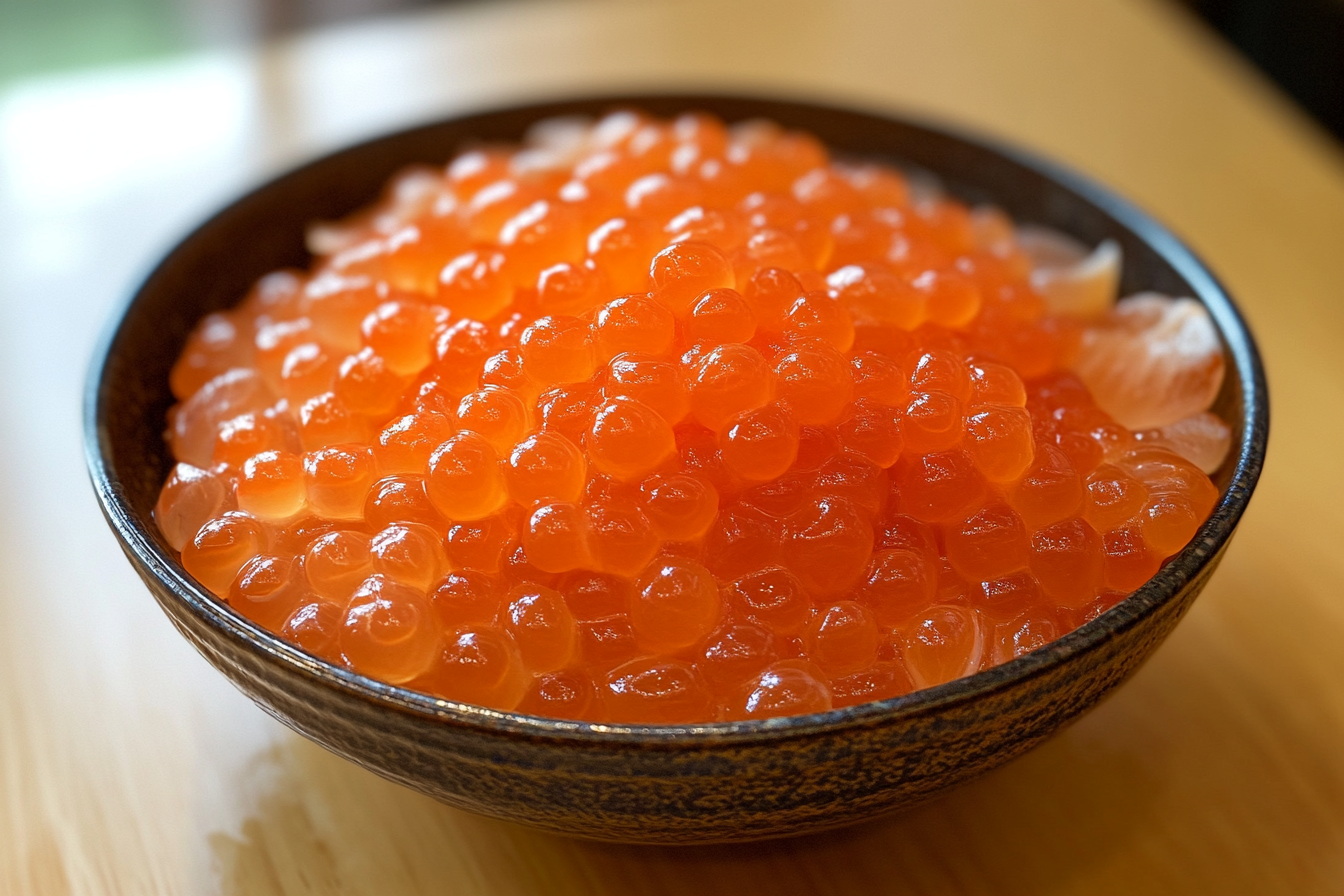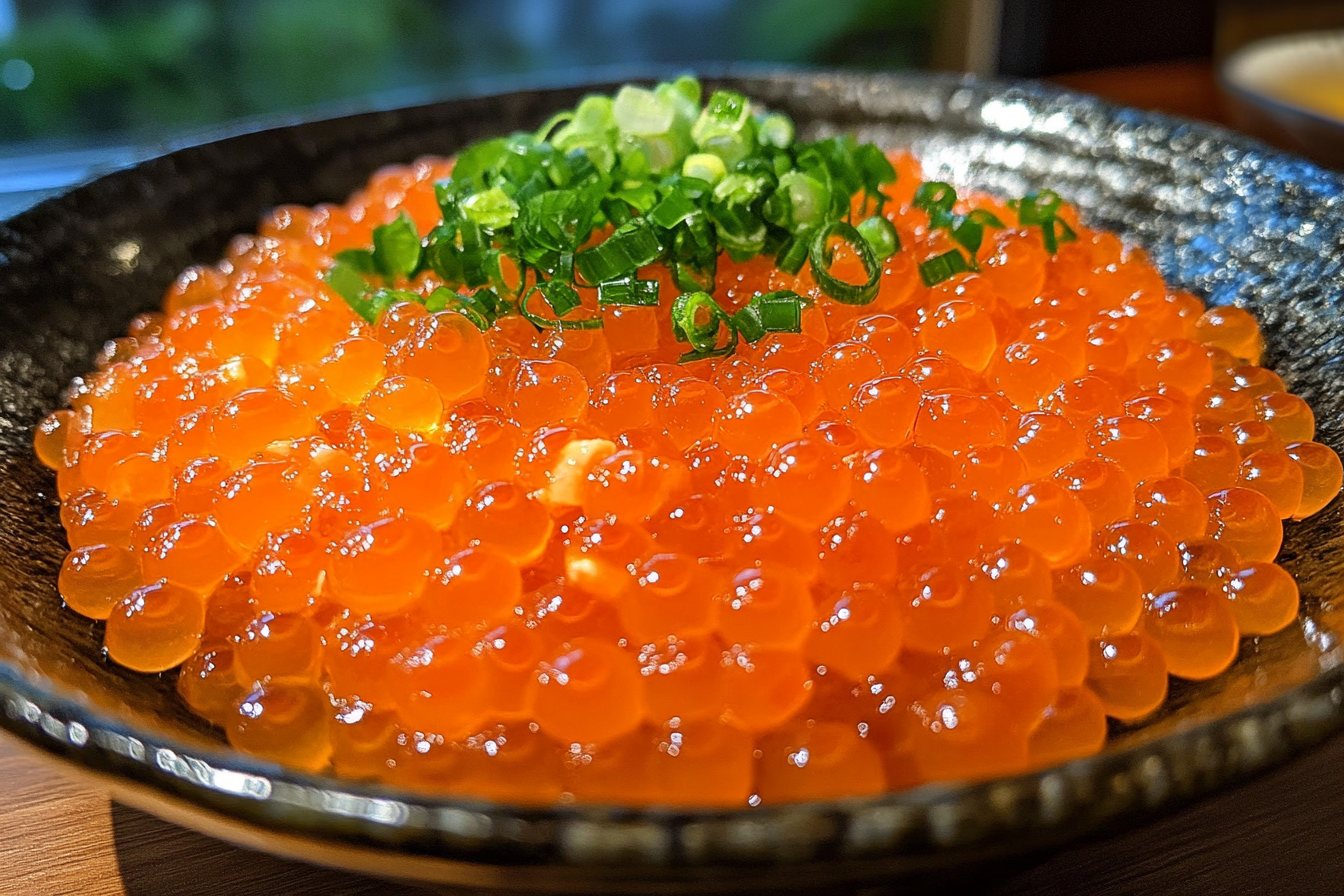When you think of sushi, many ingredients likely come to mind tuna, salmon, shrimp, and cucumber. Yet among these favorites, one stands out for its distinctive look and bold flavor: ikura. This salmon roe is not just visually striking; it also has a rich cultural and culinary history that has earned it a place of honor in both traditional and modern sushi.
This article will explore ikura in detail, from its origins and significance in Japanese cuisine to its preparation, nutritional value, and serving styles. Whether you’re a seasoned sushi lover or new to the world of fish roe, this guide will provide all the insights you need about ikura.
What is Ikura?
Ikura refers specifically to the roe or eggs of salmon. The term is often confused with other types of roe used in sushi, such as tobiko (flying fish roe) or masago (capelin roe). However, ikura is distinct, featuring large, orange, semi-translucent eggs that burst with flavor when bitten.
The name ikura is believed to have come from the Russian word “ikra,” meaning fish eggs. This makes sense, as salmon fishing and roe consumption have a long history in Russia. However, despite its Russian roots, ikura has become deeply ingrained in Japanese cuisine, where it is considered a delicacy.
The rich, salty flavor of ikura offers a briny burst that sets it apart from other sushi ingredients. Its texture, color, and flavor make it an essential element in the sushi world.
The Origins and History of Ikura in Japan
Interestingly, salmon is not native to Japanese waters. Before the 1980s, the Japanese rarely ate salmon or its roe. It wasn’t until a successful marketing campaign by Norwegian seafood companies that salmon was introduced into the Japanese diet. This promotion aimed to export Norwegian farmed salmon to Japan, and it worked phenomenally well. Within a few years, salmon along with its roe, ikura became a popular sushi ingredient.
This historical shift allowed ikura to evolve from a relatively unknown ingredient in Japanese cuisine to one of the most coveted sushi toppings. Today, ikura is celebrated not only in Japan but around the world.
For those curious about how seafood markets have evolved, you can read more about the importance of salmon in international markets with this helpful guide to salmon roe.
The Cultural Significance of Ikura in Japanese Cuisine
In Japan, ikura is seen as a luxurious ingredient. It is often served during special occasions such as New Year’s celebrations, where its bright orange hue symbolizes good fortune and prosperity. The spherical shape of the roe is also thought to represent completeness and abundance, making it a fitting ingredient for celebratory meals.
Ikura is often served alongside other delicacies like uni (sea urchin) and otoro (fatty tuna) in high-end sushi restaurants, elevating the experience with its rich flavor and texture. In contrast to more commonly found sushi ingredients, ikura retains an air of exclusivity, even in Japan.
The Taste and Texture of Ikura
Eating ikura is a unique experience for the uninitiated. When you bite into these large, orange eggs, they provide slight resistance before bursting in your mouth, releasing a burst of salty, briny liquid. This umami-rich flavor is what makes ikura so special. Unlike tobiko or masago, which offer a crunchier texture, ikura is softer, richer, and more savory.
The taste of ikura can be described as:
- Salty: due to the brining process it undergoes.
- Briny: because of its natural state as fish roe.
- Umami: a rich, savory taste that complements the flavor of sushi rice.
- Mildly sweet: depending on the marinade (often soy sauce and sake).
For many, ikura is an acquired taste, as its bold flavor can be overwhelming for first-timers. However, once accustomed to its unique qualities, it often becomes a favorite.
Pairing Ikura with Other Ingredients
Though ikura is most commonly served on its own, it can be paired with a variety of ingredients to enhance its flavor. For instance, some sushi chefs like to top ikura gunkan-maki with a quail egg yolk, which adds richness to the already savory taste. The combination of creamy yolk and salty ikura creates an indulgent bite.
Ikura is also sometimes paired with wasabi, which adds a bit of heat to balance the roe’s briny richness. The wasabi helps cut through the saltiness, creating a more balanced flavor profile. For those interested in more unique flavor combinations, you can read about other sushi pairings in this detailed guide.
Nutritional Value of Ikura
In addition to its rich flavor, ikura is packed with nutritional benefits. Here’s what you get when you consume ikura:
- High in Omega-3 fatty acids: Essential for heart health and brain function, ikura is an excellent source of these healthy fats.
- Rich in protein: A small serving of ikura contains a significant amount of protein, making it a healthy addition to your diet.
- Contains vitamins A, B, D, and E: These vitamins are vital for immune support, skin health, and energy levels.
- Low in calories: While rich in nutrients, ikura is relatively low in calories, making it a great option for those looking to enjoy a tasty treat without compromising their dietary goals.
Harvesting and Preparing Ikura
The journey of ikura from the ocean to your plate is a meticulous one. When a salmon is ready to spawn, it produces eggs inside a pouch known as suiko. This pouch is carefully removed during the fish’s processing. Care must be taken to avoid rupturing the pouch, which would damage the eggs inside.
Once removed, the eggs are gently separated from the membrane and rinsed thoroughly in cold water to clean them. After this, the ikura is ready for marination. The eggs are typically soaked in a mixture of soy sauce and sake, which not only preserves them but also enhances their flavor. This process can take anywhere from a few hours to overnight, depending on the chef’s preference.
In some cases, chefs will add additional ingredients to the marinade, such as mirin (a sweet rice wine) or kombu (kelp), to add complexity to the flavor. Once marinated, the ikura is stored in the refrigerator and used within a few days for maximum freshness.
How Ikura is Served in Sushi
Ikura is most commonly served as gunkan-maki, a sushi style in which the roe is placed on top of a small mound of sushi rice wrapped in a strip of nori (seaweed). This style allows the ikura to stand out visually and provides a perfect balance between the rice, seaweed, and roe.
In addition to gunkan-maki, ikura can be used as a topping for donburi (rice bowls) or as part of a chirashi sushi dish, where it is scattered over a bowl of seasoned rice alongside other seafood like tuna or shrimp. Ikura is also sometimes featured in sushi rolls, though this is less common than in gunkan-maki or donburi.
For a fusion experience, some restaurants offer ikura in non-traditional dishes such as ikura pasta or ikura salad, blending the rich, briny flavor of the roe with Western-style dishes. These modern interpretations allow diners to experience ikura in new and exciting ways.
Seasonality and the Best Time to Eat Ikura
While ikura is available year-round, its peak season is from September to October, when the salmon are spawning. During this time, the eggs are at their freshest, largest, and most flavorful. If you want to experience ikura at its best, it’s worth seeking out freshly harvested ikura during this period.
Outside of the peak season, most ikura is sourced from farmed salmon, which ensures a consistent supply. Farmed ikura can still offer excellent flavor, but the quality can vary depending on the farm’s practices.
The Sustainability of Ikura
As with all seafood, sustainability is a major concern when it comes to ikura. Overfishing of wild salmon populations has led to a decline in their numbers, raising ethical and environmental concerns. In response, many sushi chefs and consumers are turning to sustainably farmed salmon as an alternative.
Farmed ikura offers several advantages. It is more readily available, more predictable in terms of quality, and does not deplete wild salmon populations. However, not all farmed salmon are created equal, and it’s important to source ikura from farms that prioritize sustainable and ethical practices.
For those interested in more sustainable seafood options, be sure to read this comprehensive guide to sustainable fish practices.
Ikura in Global Sushi Culture
While ikura is most strongly associated with Japanese cuisine, it has gained popularity worldwide. In many Western countries, ikura is now a common ingredient in high-end sushi restaurants and even casual dining establishments. Its bold flavor and striking appearance make it a favorite among sushi chefs looking to create visually appealing and flavorful dishes.
In addition to traditional sushi, ikura has found its way into other types of cuisine. In some Western restaurants, you’ll find ikura paired with dishes like pasta, salads, and even eggs. These creative applications allow diners to experience the rich flavor of ikura in new and unexpected ways.
Frequently Asked Questions about Ikura
What is ikura made of?
Ikura is made from the roe or eggs of salmon. The eggs are cleaned, marinated, and served as part of various sushi dishes.
Is ikura the same as caviar?
No, while both ikura and caviar are fish eggs, caviar traditionally refers to the eggs of sturgeon, whereas ikura comes from salmon.
No, while both ikura and caviar are fish eggs, caviar traditionally refers to the eggs of sturgeon, whereas ikura comes from salmon. You can learn more about what caviar is here.
How do you eat ikura?
Ikura is typically eaten in sushi, often as part of gunkan-maki or as a topping for rice bowls.
Is ikura safe to eat raw?
Yes, ikura is safe to eat raw when sourced from reputable suppliers. It is often marinated to enhance its flavor and ensure its safety for consumption.
What is the difference between ikura and tobiko?
Ikura is salmon roe, while tobiko is the roe of flying fish. Ikura is larger and has a more robust flavor compared to the smaller, crunchy tobiko.
How is ikura stored?
Ikura should be refrigerated and consumed within a few days to maintain its freshness and quality.
With its rich history, unique flavor, and striking appearance, ikura has become a beloved ingredient in sushi dishes around the world. Whether you’re enjoying it in a traditional Japanese sushi bar or in a fusion dish that blends Eastern and Western flavors, ikura offers a burst of flavor and a textural experience unlike any other. Be sure to prioritize sustainably sourced ikura when possible, and don’t hesitate to explore the many different ways this incredible ingredient can be enjoyed in both sushi and beyond.



